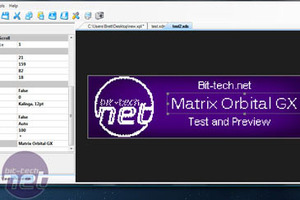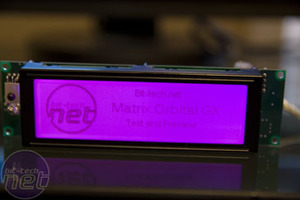
...But does it blend?
There's no doubt (at least I hope) when you read this review that I am impressed with just how far Matrix Orbital has come since our last rather unfortunate run-in.The interesting point brought up back in 2005, however, was a slew of alternatives that could be had – many priced less than the MX6 series display we were reviewing. Everything from PSOne displays to in-car video screens were shown off as very clear and almost favourable alternatives. The unspoken question was pretty much written on the wall:
Are LCD screens now a thing of the past?
If we lay the current GX Typhoon display aside, I think the answer is a very quietly mumbled "ummm, maybe...yeah, I guess." Nobody wanted to just come out and say that we could mod a seven-inch panel into our cases for less than a two-line LCD... but the fact was there. Aside from a limited fanbus and a four-button control pad, there was just not much that an LCD could offer.
However, much like spinner-rims, "hater-vision" mini-LCD TVs and under-body GroundFX car lighting, it seems that maybe it's the big and gaudy displays that may be phasing out. Sparing a VGA port on SLI systems is not possible, and the headache of managing two full screens (and the pain of Samurize) is too much for some to want to bear.
In the meantime, the good old classics of quality LCD technology are dropping a shark in the swimming pool with the GX Typhoon – some of the best parts of a full screen, some of the best parts of an old-school LCD, and the promise of add-ons that will put the idea of individual customisation back on top. The software's gone drag and drop, the hardware's gone modular and upgradeable, and the quality is everything that one would expect from the brand of Matrix Orbital.
The only question is, is it enough to entice?
Conclusion
I started the project of reviewing the GX Typhoon as one of those who thought monochrome LCD technology had well passed its heyday. But what did I end up feeling? Hope.There are things that an LCD like the Typhoon could never do. It will never be a mini movie screen. It will never show Winamp visualisations. It will also never slow my computer down or prevent me from using SLI. It will never take me more than five minutes to design a basic screen, or fifteen for a complex one.
What it will do is give me a lot of handy information at my fingertips, and I can easily add more. It will pull my weather report from the web, display my song titles and even my calendar entries. It will display my Speedfan info on my test rig, and monitor my temperatures on my main rig. It will do it colourfully, intelligently and easily. It will allow me to control Windows Media player and it will give me data on that, too.
In short, it will do everything I would ever need an intelligent display to do.
Add to this the ability for proper add-ons – a baybus that can run more than a few milliamps of current before it fries; a separate control panel that I could configure independently; a watercooling pump monitor or IR blaster for my TV or a lightbus that ties to my music beats or anything else that comes up that could be useful. And all this comes with an interface that's open and encourages users to develop more great ideas.
With the pros and cons on the table, the GX Typhoon is, to me, proof that small-scale LCD technology isn't dead...far from, it's just starting to come back into style. The classics always do.
- Build Quality
- x
- x
- x
- x
- x
- x
- x
- x
- x
- x
- 10/10
- Ease of Use
- x
- x
- x
- x
- x
- x
- x
- x
- x
- -
- 9/10
- Features
- x
- x
- x
- x
- x
- x
- x
- x
- x
- x
- 10/10
- Value
- x
- x
- x
- x
- x
- x
- x
- x
- -
- -
- 8/10
- Overall
- x
- x
- x
- x
- x
- x
- x
- x
- x
- -
- 9/10

Matrix Orbital GX Typhoon

MSI MPG Velox 100R Chassis Review
October 14 2021 | 15:04










Want to comment? Please log in.